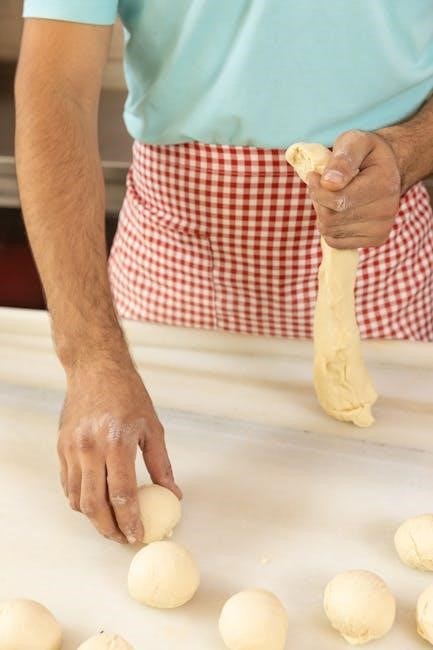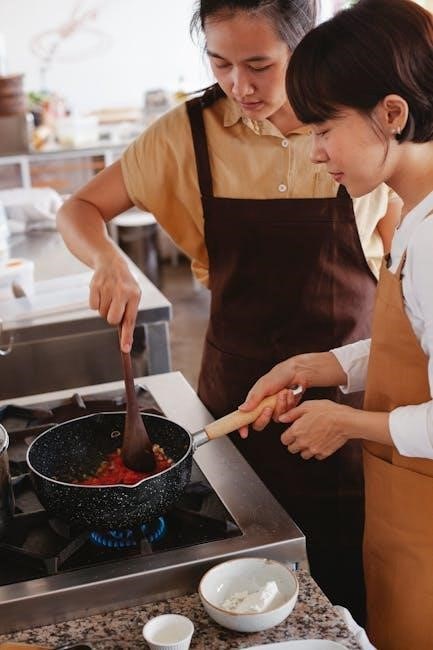turducken cooking instructions
Turducken, a unique dish combining turkey, duck, and chicken, offers a flavorful and visually impressive meal. Perfect for special occasions, it requires precise preparation and skill. Its popularity has grown since its creation, becoming a centerpiece for festive gatherings. This guide provides step-by-step instructions to master the art of Turducken cooking, ensuring a delicious and memorable experience.
1.1 Understanding the Concept of Turducken
A Turducken is a show-stopping dish consisting of a de-boned turkey stuffed with a duck, which is then stuffed with a chicken, often layered with dressing or seasonings. This multi-layered creation requires precise preparation, as all birds must be carefully deboned except for the turkey drumsticks and wing tips. The result is a flavorful, visually impressive meal perfect for special occasions. Its unique structure ensures even cooking and a harmonious blend of textures and tastes, making it a centerpiece for festive gatherings.
1.2 Brief History and Popularity of Turducken
Turducken, a dish combining turkey, duck, and chicken, originated in Louisiana as a creative culinary experiment. Its popularity surged in the early 2000s, becoming a centerpiece for special occasions like Thanksgiving. The concept of layering meats and stuffing gained widespread acclaim, with variations emerging globally. The rise of social media and cooking shows further boosted its fame, making it a sought-after dish for adventurous cooks and festive gatherings.
Essential Ingredients and Tools
Turducken requires turkey, duck, and chicken, along with seasonings like Cajun spice, kosher salt, and pepper. Stuffing ingredients include cornbread and herbs. Essential tools include poultry shears, kitchen twine, and a large roasting pan.
2.1 Required Meats: Turkey, Duck, and Chicken
For a traditional Turducken, you’ll need a 22-24 lb turkey, a 3-4 lb duck, and a 5-6 lb chicken. The turkey serves as the base, providing structure, while the duck adds rich, savory flavor. The chicken, placed in the center, ensures moisture and tenderness. Each bird must be deboned except for the turkey drumsticks and wing tips. Fresh or fully thawed meats are essential for even cooking and food safety. Proper sizing ensures harmonious cooking times and a balanced final product.
2.2 Seasonings and Stuffing Ingredients
Turducken seasoning typically includes Cajun spices, kosher salt, and black pepper for bold flavor. Stuffing often features sausage, breadcrumbs, herbs like thyme and rosemary, garlic, and onions. Some recipes incorporate brining for moisture and glazing for a crispy skin. Ensure all ingredients are fresh and complementary to enhance the dish’s complexity. Proper seasoning and stuffing preparation are crucial for a flavorful, aromatic Turducken that impresses both visually and taste-wise.
2.4 Necessary Kitchen Tools for Deboning and Assembly
To prepare a Turducken, you’ll need specific tools for deboning and assembly. Poultry shears or heavy-duty kitchen shears are essential for removing bones from the turkey, duck, and chicken. A sharp fillet knife will help with precise cuts, while a bone saw can tackle larger bones. For stuffing and layering, a large, sturdy roasting pan and a roasting rack are indispensable. Kitchen twine is required to sew the birds together securely. Additional tools like a meat thermometer and sharp utility knives will ensure a smooth process from start to finish.

Preparing the Turducken
Debone the turkey, duck, and chicken carefully, leaving wing tips and drumsticks intact. Season each layer generously with spices and herbs before assembling the layered meats.
3.1 Deboning the Birds: Step-by-Step Process
Deboning involves removing bones from the turkey, duck, and chicken while keeping the meat intact. Start with the smaller birds, such as the chicken and duck. Remove wings, necks, and spinal bones using sharp poultry shears. For the turkey, debone carefully, leaving the drumsticks and wing tips intact. Ensure all cavities are clean and ready for stuffing. This process requires patience and precision to maintain the birds’ structure for proper assembly; Proper deboning is crucial for even cooking and a seamless presentation.
3.2 Preparing the Stuffing and Seasonings
For the stuffing, combine herbs like thyme, sage, and rosemary with bread or rice. Mix in onions, garlic, and spices for added flavor. Use Cajun seasoning or kosher salt and black pepper for a classic touch. Ensure the stuffing is moist but not soggy. Let it sit for 30 minutes to allow flavors to meld. This step ensures the Turducken’s interior is as delicious as its exterior, creating a harmonious balance of tastes.

Assembling the Turducken
Layer the meats and stuffing carefully, starting with chicken, then duck, and finally turkey. Sew openings securely with kitchen twine to ensure a tight, even roll.
4.1 Layering the Meats and Stuffing
Begin by placing the deboned turkey on a large surface. Next, layer the duck inside the turkey, followed by the chicken, ensuring each bird is centered. Stuff the cavity with prepared dressing or seasoning mixture, spreading it evenly. Season each layer with spices like Cajun seasoning, salt, and pepper. Fold the turkey over the filling, wrapping it tightly around the duck and chicken. Secure the layers with kitchen twine or skewers to maintain the structure during cooking.
4.2 Sewing and Securing the Turducken
To ensure the Turducken holds its shape, sewing is essential. Use kitchen twine or heavy-duty thread to sew the openings shut, starting from the neck cavity and working around the stuffed areas. Make tight, even stitches to prevent filling from spilling during cooking. For added security, tie the legs together with twine to maintain the bird’s compact form. If the turkey breast skin tears during assembly, patch it with excess neck skin. This step guarantees a neat presentation and even cooking.
Cooking the Turducken
Cook the Turducken at 375°F, covered for 2.5-3 hours, then uncovered for 30 minutes. Use a meat thermometer to ensure an internal temperature of 165°F. Sous vide or high-heat roasting are alternatives for crispy skin and even cooking.
5.1 Oven Roasting: Temperature and Timing
Preheat your oven to 375°F (190°C). Place the turducken breast-side up and roast for 2.5 to 3 hours while covered. Uncover and continue roasting for an additional 30 minutes to crisp the skin. Ensure the internal temperature reaches 140°F to 150°F (60°C to 65°C) for food safety. Let the turducken rest for 20-30 minutes before carving to allow juices to redistribute, ensuring tender and flavorful meat.
5.2 Alternative Cooking Methods: Sous Vide and Smoking
For a modern twist, sous vide offers precise temperature control, ensuring even cooking without overcooking the outer layers. Smoking adds rich, smoky flavors, enhancing the dish’s complexity. Both methods require careful preparation but deliver exceptional results. Sous vide ensures the center reaches a safe temperature while maintaining moisture, while smoking infuses deep, savory notes. These techniques provide alternatives to traditional roasting, allowing chefs to explore new dimensions of flavor and texture in their Turducken creations.
Safety Tips and Final Preparations
- Ensure the turducken reaches an internal temperature of 165°F to avoid undercooking.
- Let it rest for 30 minutes before carving to redistribute juices evenly.
- Use a meat thermometer for accuracy and food safety.
- Carve carefully to maintain the layered structure and presentation.
6.1 Ensuring Proper Internal Temperature
Ensuring the turducken reaches a proper internal temperature is crucial for food safety and optimal flavor. The internal temperature must reach 165°F (74°C) in the thickest parts of the turkey, duck, and chicken. Use a meat thermometer to check multiple areas, especially the chicken at the center. Avoid undercooking, as this can lead to foodborne illness. Overcooking, however, can result in dry meat. Monitor closely to achieve a safe and juicy final product.
6.2 Resting and Carving the Turducken
After cooking, allow the Turducken to rest for 20-30 minutes before carving. This ensures juices redistribute, making the meat tender and flavorful. Use a sharp knife and carving fork to slice gently, avoiding tearing. Start by carving along the breast, then move to the thighs and drumsticks. Serve with gravy and sides for a memorable presentation. Proper resting and carving techniques ensure a smooth, even texture and enhance the overall dining experience.

Serving Suggestions

Turducken is best served with a rich homemade gravy, accompanied by classic sides like mashed potatoes, green beans, and cranberry sauce. Garnish with fresh herbs or fruit for a stunning presentation that elevate the festive dining experience.
7.1 Pairing with Gravy and Side Dishes
A perfectly cooked Turducken deserves complementary sides to enhance its rich flavors. Serve it with a savory homemade gravy, drizzled generously over the meat. Classic pairing options include mashed potatoes, roasted vegetables, or a flavorful stuffing. For added zest, a cranberry sauce or tangy chutney pairs beautifully with the dish. Additionally, garlic butter asparagus or sautéed spinach provides a refreshing contrast to the hearty meal. These combinations ensure a well-rounded and memorable dining experience.
7.2 Presentation Ideas for a Memorable Feast
To create a stunning presentation, carve the Turducken at the table for a dramatic effect. Garnish with fresh herbs like rosemary or thyme for a fragrant and visually appealing touch. Serve on a decorative platter with vibrant side dishes, such as roasted vegetables or colorful salads, to enhance the dish’s appeal. Consider drizzling the meat with a rich gravy and arranging it alongside a decorative pitcher of extra sauce. These touches will make the Turducken the centerpiece of a truly unforgettable feast.